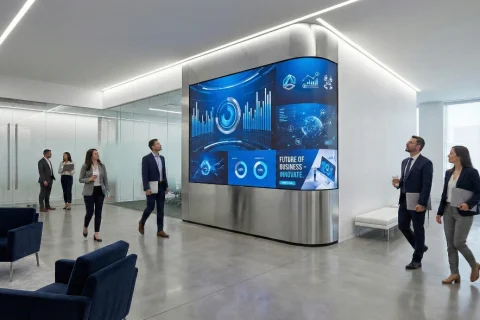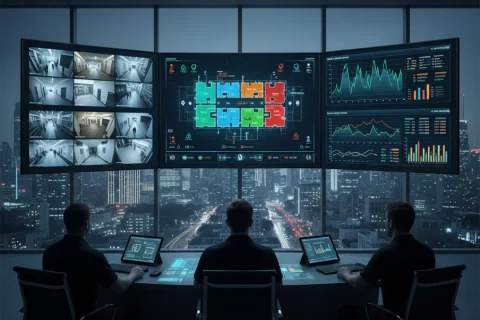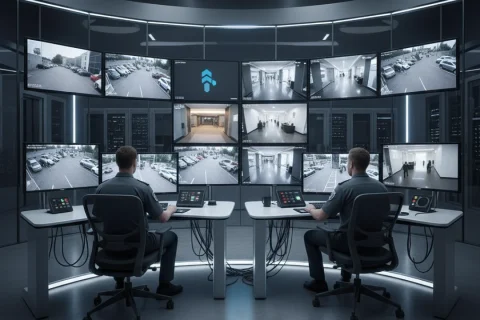Introduction
An ELV system implementation has become the backbone of modern smart infrastructure, revolutionizing how buildings operate and communicate. From enhancing security to optimizing energy management, these low-voltage solutions integrate multiple technologies into a unified framework. As businesses across the UAE and globally seek digital transformation, understanding the capabilities and applications of an ELV system is crucial for staying competitive. This comprehensive guide explores what makes these systems essential, their key components, implementation strategies, and how they drive operational efficiency in today’s connected world.
Key Takeaways
- ELV systems operate at safe voltage levels (typically under 50V AC or 120V DC) and integrate critical building technologies including security, communication, and automation systems.
- Modern electrical elv system solutions enhance operational efficiency by up to 40% while significantly reducing energy consumption and maintenance costs.
- Proper planning, scalability considerations, and professional installation are essential for maximizing the ROI of your ELV infrastructure investment.
What Is an ELV System and Why Does It Matter?
An ELV system, or Extra Low Voltage system, refers to integrated electrical installations that operate at voltage levels considered safe for human contact, typically below 50 volts AC or 120 volts DC. These systems have revolutionized building management by consolidating multiple technologies into cohesive, intelligent infrastructure.
Unlike traditional high-voltage electrical systems, an electrical elv system encompasses a wide range of interconnected technologies including CCTV surveillance, access control, fire detection, public address systems, structured cabling, building automation, and data networks. The safety profile of these systems allows for more flexible installation and easier maintenance, making them ideal for modern commercial, industrial, and residential applications. According to industry research, buildings equipped with comprehensive ELV infrastructure experience up to 35% reduction in operational costs and 50% faster emergency response times. As organizations increasingly prioritize smart infrastructure, understanding how to leverage ELV system capabilities becomes essential for long-term competitiveness and efficiency.
Core Components of a Modern Electrical ELV System
Understanding the building blocks of an effective electrical elv system helps businesses make informed decisions about their infrastructure investments. These integrated components work synergistically to create intelligent, responsive building environments.
Security and Surveillance Infrastructure Modern ELV systems begin with robust security foundations. CCTV surveillance networks with high-definition cameras, intelligent video analytics, and cloud storage provide 24/7 monitoring capabilities. Access control systems using biometric readers, smart cards, and mobile credentials ensure only authorized personnel enter sensitive areas. Intrusion detection systems with motion sensors and perimeter protection complete the security triad. These elements integrate seamlessly, triggering coordinated responses when security events occur, cameras automatically focus on detected motion while access systems lock down affected zones.
Communication and Information Systems Structured cabling forms the nervous system of any ELV infrastructure, supporting data transmission across all building systems. Public address and voice evacuation systems ensure clear communication during normal operations and emergencies. Telephone and intercom networks facilitate internal communication, while audio-visual systems in conference rooms and common areas support collaboration. Digital signage networks controlled through centralized platforms deliver real-time information to occupants and visitors. This comprehensive approach to building connectivity ensures seamless information flow throughout the facility.
Building Automation and Management Building Management Systems (BMS) represent the intelligence layer of ELV infrastructure. These platforms monitor and control HVAC systems, lighting automation, energy meters, and environmental sensors in real-time. Smart thermostats adjust temperature based on occupancy patterns and weather forecasts. Lighting systems dim or brighten automatically based on natural light availability and space utilization. Energy monitoring dashboards provide facility managers with actionable insights for optimization. Integration with IoT sensors enables predictive maintenance, identifying potential equipment failures before they cause disruptions.
Fire and Life Safety Systems Fire detection and alarm systems using smoke detectors, heat sensors, and manual call points provide early warning of fire conditions. Emergency lighting and exit signage ensure safe egress during power failures or evacuations. Gas detection systems monitor for dangerous leaks in facilities handling hazardous materials. Mass notification systems coordinate automated responses across multiple platforms such as triggering alarms, unlocking exits, directing elevators to ground floors, and notifying emergency services simultaneously.
7 Strategic Benefits of Implementing an ELV System
Organizations that invest in comprehensive ELV infrastructure gain multiple competitive advantages that extend far beyond basic functionality. Here’s how these systems deliver measurable business value.
1. Enhanced Security and Risk Mitigation Integrated security systems reduce theft, vandalism, and unauthorized access by up to 67%, according to security industry studies. Real-time monitoring with intelligent analytics detects suspicious behavior patterns before incidents escalate. Automated access logs create audit trails for compliance requirements. Emergency response coordination through integrated platforms reduces incident resolution time by an average of 45%, minimizing potential losses and liability exposure.
2. Operational Efficiency and Cost Reduction Building automation through ELV systems generates substantial operational savings. Energy management features reduce consumption by 25-40% through optimized HVAC scheduling, occupancy-based lighting control, and demand response capabilities. Preventive maintenance alerts based on equipment performance data decrease emergency repairs by 60% and extend asset lifespans. Centralized monitoring allows smaller facility management teams to oversee larger properties effectively, reducing labor costs while improving service levels.
3. Scalability and Future-Readiness Modern electrical elv system architectures embrace modularity and open standards, enabling seamless expansion as business needs evolve. Organizations can add new cameras, access points, or automation zones without replacing existing infrastructure. IP-based systems leverage existing network infrastructure, reducing deployment costs for additional capabilities. This flexibility protects technology investments over 10-15 year lifecycles, even as individual components advance. Companies can adopt emerging technologies like AI-powered analytics or IoT sensors incrementally rather than through disruptive overhauls.
4. Improved Occupant Experience and Productivity Smart building features enhance comfort and convenience for occupants. Mobile apps allow employees to control office environments, book meeting rooms, and access facilities using smartphones. Wayfinding systems guide visitors through complex facilities efficiently. Optimal lighting and temperature conditions based on preferences and tasks boost productivity by 8-12% according to workplace studies. Reduced noise from HVAC optimization and improved air quality monitoring contribute to healthier, more productive work environments.
5. Regulatory Compliance and Standards Adherence Comprehensive ELV systems help organizations meet increasingly stringent building codes, fire safety regulations, and accessibility standards. Automated documentation of system performance and maintenance activities simplifies compliance audits. Fire and life safety systems meeting international standards (NFPA, BS, IEC) protect against regulatory penalties and insurance complications. Professional implementation ensures adherence to local electrical codes and safety requirements from the outset.
6. Data-Driven Decision Making Integrated building management platforms aggregate data from thousands of sensors and devices, providing unprecedented visibility into facility operations. Analytics dashboards reveal space utilization patterns, enabling optimized real estate strategies. Energy benchmarking identifies inefficiencies and quantifies improvement opportunities. Occupancy analytics inform scheduling decisions for maintenance, cleaning, and security personnel. This intelligence transforms facilities from cost centers into strategic assets that actively support business objectives.
7. Business Continuity and Resilience Redundant systems architecture and failover capabilities ensure critical operations continue during equipment failures or power disruptions. Backup power supplies maintain essential systems during outages. Remote monitoring allows facility teams to respond to issues proactively, often resolving problems before occupants notice. Disaster recovery protocols integrate with emergency notification systems, coordinating evacuation procedures and business continuity activation seamlessly.
Key Considerations When Choosing Your ELV System
Selecting the right electrical elv system requires careful evaluation of technical requirements, business objectives, and long-term strategic goals. Organizations should approach this investment with the same rigor applied to other critical infrastructure decisions.
Assess Current and Future Requirements Begin with comprehensive needs analysis covering all building systems and stakeholder requirements. Involve IT, facilities, security, and business unit leaders in defining functional specifications. Consider growth projections for headcount, building expansions, and technology adoption over the next decade. Document integration requirements with existing systems and corporate platforms. This foundation ensures your ELV architecture aligns with business strategy rather than simply replacing outdated equipment.
Prioritize Interoperability and Open Standards Avoid proprietary systems that create vendor lock-in and limit future flexibility. Specify solutions based on industry standards like BACnet for building automation, ONVIF for video surveillance, and SIP for communication systems. Open protocols enable best-of-breed component selection and simplify system expansions. Ensure integration capabilities extend to enterprise platforms including ERP systems, facility management software, and business intelligence tools. This approach maximizes the value of data generated by your ELV infrastructure.
Evaluate Total Cost of Ownership Look beyond initial installation costs to understand long-term financial implications. Consider energy savings, maintenance requirements, software licensing models, and expected equipment lifecycles. Calculate return on investment based on quantifiable benefits like reduced energy consumption, lower insurance premiums, and improved operational efficiency. Factor in training requirements and potential disruption during implementation. Organizations typically achieve payback on ELV investments within 3-5 years through combined savings and productivity improvements.
Plan for Cybersecurity from the Start As ELV systems increasingly connect to corporate networks and cloud platforms, cybersecurity becomes paramount. Implement network segmentation to isolate building systems from business networks. Require strong authentication, encryption, and regular security updates for all connected devices. Establish policies for password management, firmware updates, and vulnerability monitoring. Work with vendors who prioritize security in product development and provide long-term support for security patches. Security integration strategies should address both physical and cyber threats comprehensively.
Select Experienced Implementation Partners The success of ELV projects depends heavily on design quality and installation craftsmanship. Choose partners with proven experience in similar facility types and project scales. Verify certifications from equipment manufacturers and industry associations. Review completed projects and speak with references about post-installation support quality. Ensure contractors provide comprehensive documentation, operator training, and responsive maintenance services. The right partner transforms an ELV system from a collection of products into an integrated platform that delivers sustained value.
Implementation Best Practices for Maximum ROI
Successfully deploying an electrical elv system requires methodical planning and execution across multiple phases. Organizations that follow proven implementation frameworks achieve better outcomes with fewer complications.
Phase 1: Strategic Planning and Design (8-12 weeks) Develop detailed system architecture documentation that maps functional requirements to technical specifications. Create cable pathway designs that accommodate current installations and future expansions. Establish design standards for component selection, naming conventions, and documentation practices. Coordinate with architects and engineers to integrate ELV requirements into construction schedules. Obtain necessary permits and approvals before procurement begins.
Phase 2: Procurement and Pre-Installation (6-10 weeks) Issue requests for proposals based on detailed specifications rather than generic product categories. Evaluate vendor responses on technical compliance, total cost of ownership, and implementation timelines. Negotiate service level agreements for system uptime, response times, and maintenance support. Conduct factory acceptance testing for critical components before shipment. Verify compatibility between different system elements through integration testing.
Phase 3: Installation and Commissioning (timeline varies by scale) Follow structured installation methodologies with quality checkpoints at each milestone. Test cable runs and terminations before connecting equipment. Commission individual subsystems before attempting full integration. Document as-built conditions including cable routes, device locations, and configuration parameters. Train facility staff on system operation, basic troubleshooting, and maintenance procedures. Conduct acceptance testing with stakeholders to verify all functional requirements are met.
Phase 4: Optimization and Ongoing Management Monitor system performance during the initial months to identify optimization opportunities. Fine-tune automation sequences based on actual usage patterns and occupant feedback. Establish preventive maintenance schedules for all equipment categories. Update documentation as changes occur during the warranty period. Schedule periodic reviews to assess whether the system continues meeting evolving business needs.
Industry Applications of ELV Systems
Different sectors leverage electrical elv system capabilities in unique ways, addressing industry-specific challenges while gaining common benefits around efficiency, security, and intelligence.
Commercial Real Estate and Corporate Facilities Office buildings use ELV systems to create flexible, technology-enabled workspaces that attract and retain tenants. Smart parking systems guide drivers to available spaces while collecting usage data for optimization. Visitor management systems streamline check-in processes and enhance security. Building analytics platforms benchmark performance across portfolios, identifying improvement opportunities and best practices. Real estate implementations demonstrate how ELV infrastructure directly impacts asset value and tenant satisfaction.
Manufacturing and Industrial Operations Production facilities integrate ELV systems with industrial control systems to enhance safety and operational efficiency. Machine monitoring sensors detect anomalies that could indicate impending failures. Environmental monitoring ensures optimal conditions for sensitive processes and materials. Access control systems restrict entry to hazardous areas while tracking personnel location for emergency accountability. Manufacturing applications show how ELV technology supports operational excellence and continuous improvement initiatives.
Retail and Hospitality Shopping centers and hotels use integrated ELV systems to enhance customer experience while optimizing operations. Queue management systems integrate with digital signage to direct customers efficiently. Centralized music and announcement systems create desired ambiance while enabling instant communication during emergencies. Energy management reduces utility costs without impacting comfort. Integrated security systems prevent theft while gathering analytics on traffic patterns and customer behavior. Retail implementations demonstrate measurable improvements in sales performance and customer satisfaction metrics.
Infrastructure and Critical Facilities Airports, hospitals, and utilities require highly reliable ELV systems with redundancy and failover capabilities. Mission-critical communication systems remain operational during disasters or major incidents. Sophisticated access control with biometric verification protects sensitive areas. Mass notification systems coordinate complex emergency responses across sprawling facilities. Comprehensive monitoring ensures regulatory compliance while documenting system performance for audit purposes. Infrastructure projects showcase the role of ELV systems in maintaining public safety and service continuity.
The Future of ELV Technology
Emerging technologies continue expanding the capabilities and value proposition of electrical elv system installations. Organizations planning ELV investments should consider how these trends will impact their infrastructure strategies.
Artificial Intelligence and Machine Learning AI-powered video analytics move beyond simple motion detection to recognize specific objects, behaviors, and anomalies. Predictive maintenance algorithms analyze sensor data to forecast equipment failures days or weeks in advance. Energy optimization systems learn building characteristics and occupancy patterns, automatically adjusting operations for maximum efficiency. Natural language interfaces allow building occupants to control environments through voice commands. As AI capabilities mature, the intelligence and autonomy of ELV systems will increase dramatically.
Internet of Things and Edge Computing Proliferation of inexpensive IoT sensors enables monitoring of previously untracked parameters—desk occupancy, equipment utilization, indoor air quality, and acoustic comfort. Edge computing processes sensor data locally, reducing network bandwidth requirements while enabling real-time responses. Digital twins create virtual replicas of physical buildings, supporting simulation and optimization before implementing changes. This convergence of IoT and ELV systems creates unprecedented visibility into building performance.
Cloud Integration and Remote Management Cloud-based platforms enable centralized management of geographically dispersed facilities from any location. Software-as-a-service models reduce upfront costs while ensuring automatic updates and new feature access. Mobile applications give facility managers and occupants control over building systems from smartphones. Cloud analytics aggregate data across multiple properties, revealing patterns invisible when examining individual sites. This shift from premise-based to cloud-centric architectures improves accessibility while reducing IT overhead.
Conclusion
An ELV system represents far more than a collection of security cameras and access control devices—it’s the foundation for intelligent buildings that adapt to occupant needs while optimizing resource consumption. From enhancing security and compliance to enabling data-driven decision making, comprehensive electrical elv system infrastructure delivers measurable returns across operational, financial, and strategic dimensions. As organizations across industries embrace digital transformation, the question isn’t whether to invest in ELV technology, but how to maximize the value of these critical systems. By following proven planning methodologies, selecting the right technology partners, and embracing emerging capabilities, businesses can create smart infrastructure that supports their objectives today while remaining flexible for tomorrow’s innovations.
Ready to transform your facility with state-of-the-art ELV solutions? Contact Vega Digital IT Solutions to discuss how our expertise can help you design and implement systems that deliver lasting value.
Frequently Asked Questions
What is an ELV system in buildings?
An ELV system (Extra Low Voltage system) integrates building technologies operating below 50V AC, including CCTV, access control, fire alarms, and automation. These systems enhance security, connectivity, and operational efficiency while maintaining safe voltage levels for occupants.
How does an electrical ELV system improve building security?
Electrical ELV systems combine CCTV surveillance, access control, and intrusion detection into unified platforms. This integration enables real-time monitoring, automated threat responses, and comprehensive audit trails, reducing security incidents by up to 67% while streamlining emergency coordination.
What are the main components of an ELV system?
Core components include security systems (CCTV, access control), communication infrastructure (structured cabling, public address), building automation (BMS, lighting control), and life safety systems (fire detection, emergency lighting). These elements integrate to create intelligent, responsive building environments.
How much does it cost to install an ELV system?
ELV system costs vary based on building size, complexity, and features required. Typical installations range from $15-50 per square foot. Organizations typically achieve ROI within 3-5 years through energy savings, reduced maintenance costs, and improved operational efficiency.
Can ELV systems reduce energy consumption?
Yes, electrical ELV systems reduce energy consumption by 25-40% through automated HVAC scheduling, occupancy-based lighting control, and demand response optimization. Building management platforms continuously monitor and adjust systems for maximum efficiency while maintaining occupant comfort.
What is the difference between ELV and LV systems?
ELV systems operate below 50V AC (Extra Low Voltage), considered safe for human contact, handling security and automation. LV systems (Low Voltage) operate at 50-1000V AC, powering lighting and equipment. Smart ELV implementations integrate seamlessly with building infrastructure.
How long does ELV system installation take?
Installation timelines vary by project scope. Small offices require 2-4 weeks, while large commercial buildings need 3-6 months. Proper planning, including design, procurement, installation, and commissioning phases, ensures successful deployment without disrupting operations.
Are ELV systems compatible with existing building infrastructure?
Modern electrical ELV systems integrate with existing infrastructure through open protocols and standards like BACnet, ONVIF, and SIP. Retrofit installations leverage current network cabling and systems, enabling phased upgrades without complete overhauls or significant disruption.
What industries benefit most from ELV systems?
All sectors benefit, but commercial real estate, healthcare, manufacturing, retail, and hospitality see significant advantages. IoT-enabled solutions enhance operations across industries by improving security, reducing costs, and enabling data-driven decision-making for competitive advantage.
Do ELV systems require regular maintenance?
Yes, preventive maintenance ensures optimal performance and longevity. Regular inspections, software updates, and system testing should occur quarterly. Professional maintenance programs identify issues early, reduce emergency repairs by 60%, and extend equipment lifecycles beyond standard warranties.









